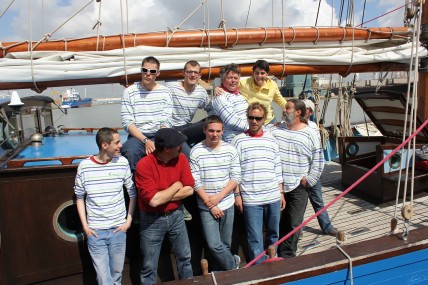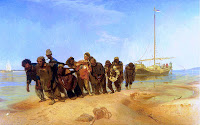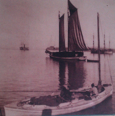 [This report covers, not surprisingly for followers of this publication, the SAIL consortium conference in Rotterdam Nov. 6-8, 2013.] There comes a time when everything else must stop, when a crisis is staring you in the face. Perhaps like a speeding train coming at you. This is one of those times, far and away the biggest event in human history. Coverage and commentary: Methane Levels going through the Roof - from Arctic-News.blogspot.nl, Nov. 11, 2013: |
|||
 The young man sat on the pebbly beach, looked out over shades of turquoise framed by pine-studded points of sunlit land, and said to himself, "This is the place to be." The next minute he noticed around him a couple of cigaret butts and bits of degraded plastic, and wondered aloud, "How can anyone harm nature?" Then in a matter of seconds he questioned who the hell he was to point a finger at any polluters, when he had taken a jet plane and used a car to get to this almost unspoiled spot. It was great to be in the Aegean instead of back in the States, but what was the worth of running around the globe trying to spice things up for a more meaningful life? |
|||
 Note: this op-ed was featured on Truthout.org on Aug. 24, 2013. A consensus seems to be building toward anticipating collapse. So what's your flavor? Financial meltdown with chaos? Petrocollapse? Climate extinction? The contributing crises are seemingly diverse, including Fukushima's mounting radioactive releases into the Pacific, the growing plastic plague and creeping GMO contamination. If none of those are your thing, you can acknowledge accelerating bee colony collapse. |
|||
 The nations and waters of the North Sea comprise the modern world's most intensive sail transport environment. For those readers and sailors who have cheered on the Tres Hombres schooner-brig, and noted the creation of numerous sail transport projects here and there, the big eye-opener in terms of united international resolve can now be revealed: The European Union's SAIL project, part of the North Sea Region Program whose theme is "Investing in the future." SAIL's mission is to bring about the construction and operation of the first Wind Assisted Ship Propulsion (WASP) large cargo ship. |
|||
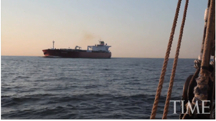 The Aug. 7 video by Time Magazine's Bryan Walsh is the best one I've seen on global sail transport trends. As it is only a bit over 5 minutes, you can get brought up to speed and sense the excitement that is spreading. Time's coverage centers on Fair Transport's Tres Hombres schooner-brig and the group's plans for a four masted ecoliner to be four times as long as the 32-meter Tres Hombres. |
|||
 This state of affairs can't last.
"Art is the Permanent Revolution" - memo to Culture Change Jan Lundberg, founder of Culture Change and Sail Transport Network, said "Fernando Agudelo is a concept artist, designer, and creative illustrator living in Hollywood, Florida. He proves that a piece of art such as the right picture paints a thousand words, and it does even more. In offering his new painting Global Warming, out of the blue, to be shared on CultureChange.org and SailTransportNetwork.org, he explained: |
|||
 This major news article got the attention of folks in the sail transport movement: It is a boost to our movement when it is seen that some of the vast "oil money" from the corporate global economy starts to be transfered to sustainability. This confirms what more and more people are aware of: sail transport is on the rise and cannot fail to fulfill the promise of ultra-efficient, clean energy for travel and trade. |
|||
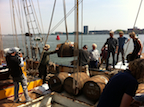 unloading sailed rum
A sailboat can be part of nature, a living state that no motorboat can ever accomplish. This makes intellectual sense, but you feel it on the sea especially in a wooden boat under sail. The relationship between a human being and the sea is intimate and deep. It is also the basis of the current revival of sail transport. |
|||
More than 3,000 bottles of wine have been sailed into London by a new company keen to demonstrate the environmental benefits of old-fashioned wind power. It looks like a relic from a bygone age, but the 20-metre wooden sailing boat anchored in London's St Katharine dock could be a sign of things to come, according to Guillaume Le Grand, founder of TransOceanic Wind Transport (TOWT). |
|||
This article was originally published on ClubOrlov.com
|
|||


